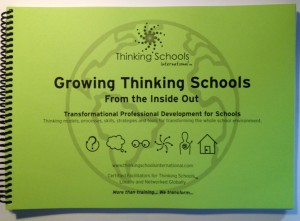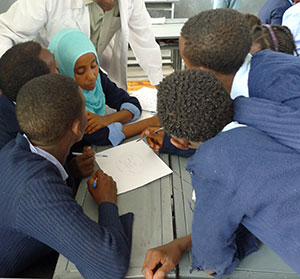


 School-wide
School-wide
Ethos
School-Wide Ethos reflects the quality of the thought-filled interactions between and among people within the school and the larger educational community and the ways in which all members actively demonstrate respect for each other and the capacity to invite and consider multiple perspectives.
Thinking Schools Accreditation Process
By engaging the entire school community in a process of self-study, becoming accredited as a Thinking School provides a meaningful opportunity for continuous learning and creates an enduring culture of reflective practice. Over 80 schools have elected to participate in a voluntary accreditation process in order to reflect on, deepen, and sustain their development as a Thinking School. These schools have chosen to use the accreditation process as an opportunity to demonstrate and affirm their commitment to the principles of becoming a Thinking School.
read more about the process
Guiding Criteria:
10. Assessment to Inform
Differentiated forms of both formative and summative assessment are used to inform instructional and learner decision-making.
11. Reflective Thinking
Reflective assessment of thinking is an explicit, regular dimension of everyday classroom practice.
12. Interactive Assessment
Students, as well as teachers, are actively involved in the assessment processes and opportunities exist for both of them to use these processes to develop as autonomous learners and teachers.
read more
Guiding Criteria:
13. Whole School Culture
The organizational structure and visual presentation of the school reflects a positive, caring and creative atmosphere representing all stakeholders.
14. Collaborative Community
Regular opportunities, across roles and responsibilities, are designed for school members to discuss and reflect on the teaching and learning experiences related to the development of a thinking school.
15. Global Networking
The school actively develops opportunities for collaboration within and beyond the school community, including other schools in the TSI network.
read more
What is the Thinking Schools Accreditation Process (TSAP)?
The Thinking Schools Accreditation Process (TSAP) offers an opportunity for schools to engage in a systematic, collaborative, enquiry process. The framework for accreditation is based on 5 Key Areas for Reflection and 15 Criteria representing the vision of directly facilitating thinking as a foundation for early childhood through adult education and for nurturing all students as global citizens.
 Working toward becoming a Thinking School is a developmental process, one that continues to mature and deepen over time. Schools on this journey generally pass through three stages, Level 1—Emerging, Level 2—Integrating, and Level 3—Sustaining.
Working toward becoming a Thinking School is a developmental process, one that continues to mature and deepen over time. Schools on this journey generally pass through three stages, Level 1—Emerging, Level 2—Integrating, and Level 3—Sustaining.
A school might elect to wait until it has progressed through the early stages of development as a Thinking School before it engages in the formal accreditation process. Some schools, however, may be interested in participating in a formative review process in order to have the added benefit of feedback along the way. Participating in a formative review process provides schools with immediate and timely input from accrediting partners that can affirm, energize and guide the school’s development as it progresses toward its vision.
The formal Thinking Schools Accreditation Process (TSAP) is an opportunity for schools to engage in a systematic, highly descriptive, enquiry process focused on the 5 Key Areas for Reflection and the 15 Criteria. The 5 Key Areas for Reflection and 15 Criteria provide the guidelines through which a school and its accrediting partner can make determinations regarding the schools development as a Thinking School. The primary purpose of this process is for the school to use the information they generate to continue to inform, guide, and inspire their ongoing development as a thinking school.
read more on the criteria
The primary purpose for schools to engage in seeking accreditation is to help create an environment of self-study and assessment within each school community. This focus on “reflective practice” is fostered through guidance and feedback from informed “critical friends” on our TSAP team. The process of collecting and reflecting on artifacts like classroom work, videos, and photos practical use of a range of models for thinking becomes a catalyst for continuous improvement. Schools use the information they generate to continue to inform, guide, and inspire their ongoing development.
 A second purpose is to network with other schools that have already become accredited and learn from the processes, feedback, outcomes, and insights from educators and students around the world.
A second purpose is to network with other schools that have already become accredited and learn from the processes, feedback, outcomes, and insights from educators and students around the world.
A third purpose is based on authentic recognition of learning across a whole school: accreditation as a Thinking School offers each school recognition for making well documented shifts toward student centered learning for global citizenship.
Formal certification and publication of the TSAP Portfolio also offers students, teachers, parents and community members an opportunity for celebrating their efforts and outcomes… and for projecting the school culture forward toward deeper, sustained implementation.
view a composite example
The school community meets to decide whether or not to engage in the Thinking Schools Accreditation Process. This often happens after the school has already begun implementation of their own plan for implementing a Thinking Schools approach. If the decision is to move forward, the school contacts Thinking Foundation and is linked to an accrediting partner who will guide them through the process. There are six basic steps of the process: Initiation; Preparation; Self-Study; Accrediting Partner Review; Action Plan; and Dissemination.
A representative from the accrediting partner meets (in-person or online) with the school’s Drive Team to explain the process, clarify the 5 Key Areas for Reflection and the 15 Criteria, and assist the school in establishing a preliminary timeline for the accreditation process. Requirements for submitting a web-based portfolio of the school’s self-study are explained and any technical support the school needs is discussed.
read more on the process





